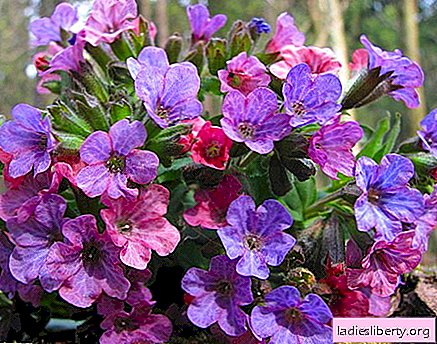
Lungwort - general description
Kind Lungwort - These are low perennial plants of the Borage family. The branched rhizome sprawls shallow underground. In the spring, low stems develop from it: as a rule, from ten to thirty centimeters. The leaves of the Lungwort are sessile, elongated, lowered, and are rough. At the top of the stem, flowers bloom that have an interesting feature. At the beginning of flowering, their corolla with petals is endowed with a pink color, and at the end they turn blue. The flowering period falls on March-April.
Lungwort - types and places of growth
The genus of Lungwort is not numerous and has only 14 species, which grow mainly in the countries of Eurasia. Lungwort lives in deciduous forests, hedges, it can also be found in shrubbery and shady places. Of the few types of aesthetic and medicinal value, only a few species have:
- Lungwort hairy - lives everywhere, is common in Russia;
- Lungwort medicinal - is cultivated as an ornamental plant, which is also used for medicinal purposes. It grows in the forest strip of Europe, and is also found on the British Isles. Russian habitat - Kaliningrad region;
- Lungwort is dark (or obscure) - it lives in Europe and European Russia, occupies forest and forest-steppe zones. It is a popular ornamental plant belonging to the group of "snowdrops".
Other less significant species include Lungwort narrow-leaved, mountain, red, sugar, shafted, softest, long-leaved, etc.
Lungwort - healing properties
Lungwort medicinal has been used in folk medicine since ancient times. It is used as an expectorant, diuretic, emollient, analgesic, hemostatic, anti-inflammatory drug, as well as for the treatment of pulmonary-bronchial (asthma, bronchitis, pneumonia, tuberculosis) and gastrointestinal diseases. An external medicinal plant is used for skin diseases. In some countries, for example, in England, the leaves of the Lungwort are eaten.
Lungwort - dosage forms
The aerial part of the plant is harvested and dried: flowering shoots with leaves are cut off at the very surface of the soil and dried in small bunches in limbo. You can dry in the sun in an open space or indoors with artificial heating (up to 40 degrees), ventilation should be mandatory. Further, all parts are ground, ground into powder and used to prepare medicinal infusions, decoctions, etc. The shelf life of the finished extract is no more than two years.
Lungwort - traditional medicine recipes
Infusion for bowel diseases, gastritis, peptic ulcer, hemorrhoids and diarrhea: pour a handful of dry grass in a liter of boiling water, let it brew for 2 hours, then strain, throw out the grass, and use the infusion half a glass several times a day. To achieve the best result, the grass of the Lungwort can be mixed with chopped flax seed.
A decoction for pulmonary-bronchial diseases: two or three tablespoons of the lungwort pour 400 g. boiling water, insist a couple of hours, then squeeze the raw materials and take inside a hundred milliliters 3-5 r. in a day. A more concentrated broth is used for lotions and rinses for ulcers, boils, festering wounds, rashes, etc.
Dishes from the leaves of Lungwort are also useful for severe coughing, bronchitis and pneumonia (as an additional remedy for the main therapy, of course), and freshly squeezed juice and gruel from the leaves have an antiseptic and wound healing effect, relieve itching (rub the juice into the skin), moisturize and treat cracked heels, eliminates corns and corns.
Lungwort - contraindications
There are no contraindications to the use of medunica-based drugs. It is worth highlighting only individual intolerance and children's age up to 3 years.
Comments











